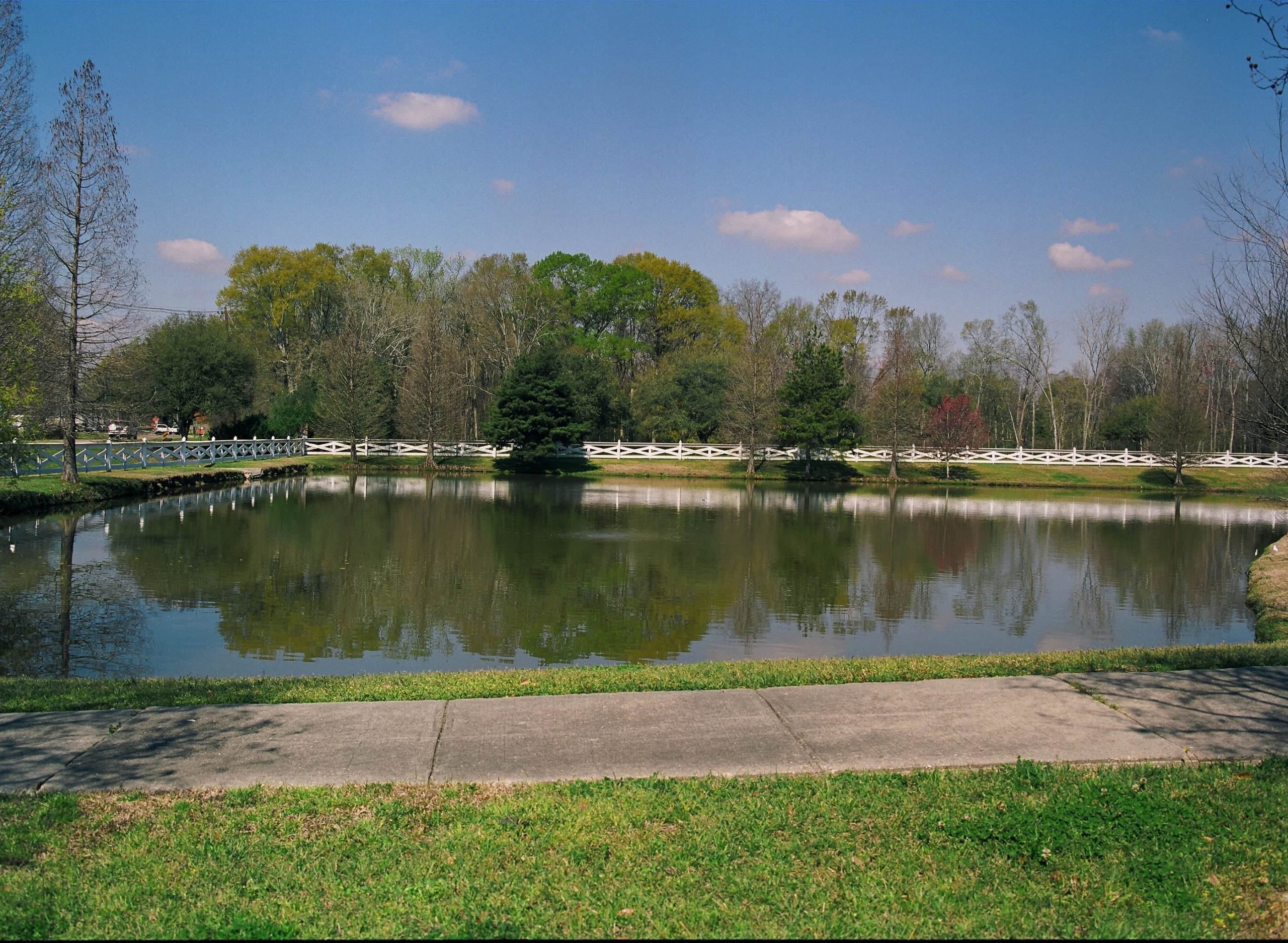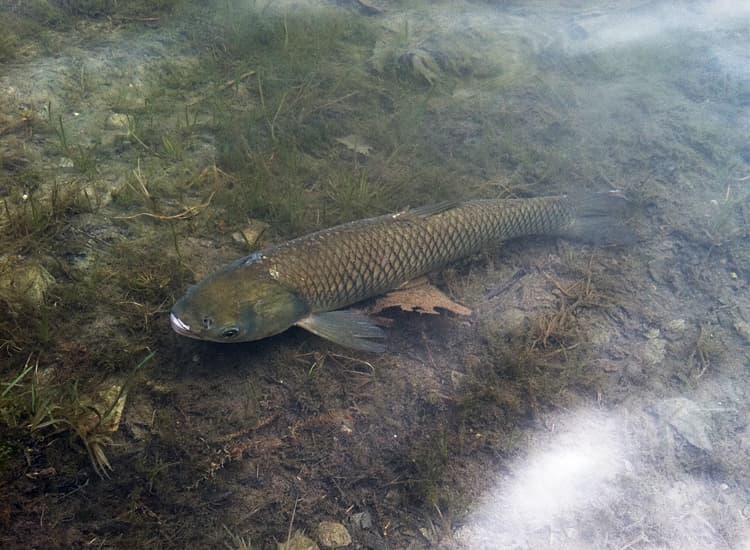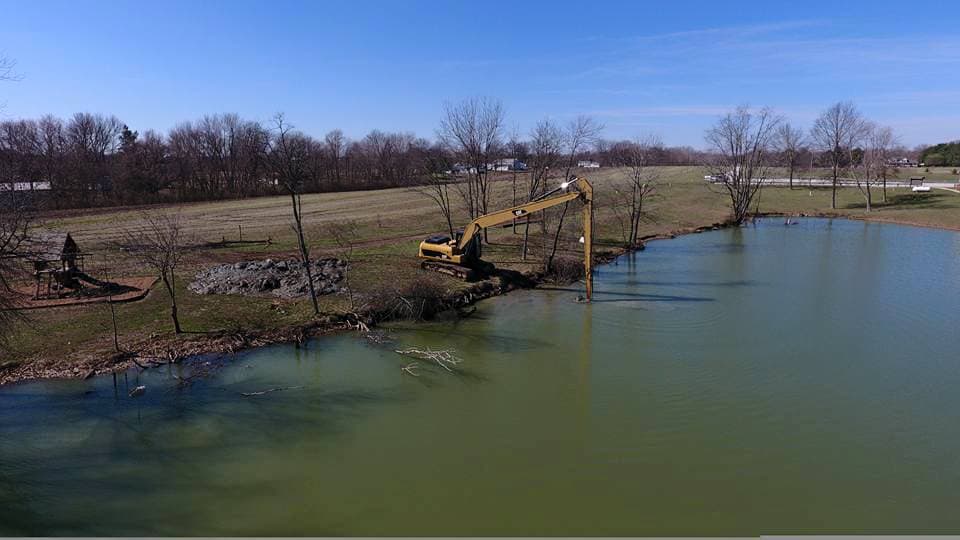There are a number of ways to manage and treat aquatic plants. Some are similar to Algae treatments and others are different due to the nature and differences between algae and other aquatic plant species. Below is a listing of some of the common ways to manage aquatic plants and how they work.
Physical Removal
As the name implies, this is simply the physical removal of the plants. This can be accomplished in a number of ways. Hand removal typically consists of weed cutters and/or weed rakes to cut and pull weeds out of the pond. This can be very effective in smaller ponds or to spot treat areas in larger lakes. Not only does it remove the plants which can be a nuisance, it also removes a lot of the nutrients from the system. Make sure to remove the plants far enough from the pond edge so they do not wash back in when it rains. Also keep in mind, some plants spread by fragmentation so cutting or pulling and having fragments drift to other parts of the pond or lake can spread the species further.
In larger lakes, a weed harvesting machine may be a better approach. While more costly, a weed harvester can more quickly address large areas or areas people just cannot reach with a cutter or rake. The same concerns with fragmentation and disposal would apply here as well.

Chemical Treatments

There are several chemical treatment options available for aquatic plant problems. Some treat certain aquatic plants better than other treatments, and since there are many types of aquatic plants, it is a good idea to talk with a local lake management professional to get some assistance in identifying the type of aquatic plant problem and develop a plan for the best solution to that problem. New federal laws often require permits and licensed professionals to perform chemical treatments.
Copper – Copper is usually the first answer most people get when they bring up the subject of algae and control. Copper is toxic to certain species of fish within the minnow family as well as salmonids depending on the dosage and water chemistry. Water with high hardness and alkalinity buffers copper from being toxic, but also limits its effectiveness. The most common form of commercially available copper is granular copper sulfate. Its effectiveness and cost as a broad spectrum controller of planktonic and filamentous algae has led to its high usage. Liquid chelated copper products are used to control a broad range of algae including planktonic, filamentous, and bottom attached types of algae. Consistent usage of some copper products can lead to bioaccumulation within the sediments and this approach is on the radar of some regulatory agencies, so a varied approach is probably the most sensible path to take.
Diquat Herbicide – Diquat is a liquid, contact herbicide that is sprayed on the vegetation. This is a very powerful and fast acting form of aquatic weed and algae control. The treated vegetation will quickly die and turn brown from this treatment. A lake management professional will be able to assist with information and application of this product.
Fluridone Herbicide – Fluridone is a liquid, non contact herbicide that is slower process than the diquat herbicide, but does not have the same restrictions for water usage afterwards. The herbicide is absorbed into the plants and symptoms develop within 1 to 2 weeks. Affected plants will lose their green pigment and turn white. This can be a more selective method of treatment depending on application levels.

Biological Treatments

Organisms can be used to help control and prevent aquatic weed growth in ponds. Biological treatments may not work as fast as chemical treatments, but can be effective and a long term solution to problems. This method works better in smaller scale applications and it is important to contact a lake management professional before introducing organisms into your pond because you could see negative effects from this. Some common biological treatments are other plant species, plant eating fish, and bacteria.
Aquatic Plants – Often times introducing more desired species of plants can assist in helping rid the pond of a nuisance species. Native plants are usually a good bet because they have more checks and balances with the local environment. This can be difficult because invasive species are often present because they can successfully out compete desirable plants. This method works better when the invasive plants are removed.
Plant Eating Fish – Introducing plant eating fish, or herbivores, can assist in limiting plant growth. Grass Carp are being used to help control aquatic vegetation. They are bred to be sterile so they will not reproduce in the pond and will eat vegetation in the pond. Grass Carp do not like all forms of vegetation and there are various restrictions on their use, so consult a local professional or regulatory agency. They also do not eat algae, contrary to popular belief, so they can shift your pond from aquatic plants to algae growth.
Bacteria – Bacteria and fungi can be used to help control aquatic plant growth. Certain varieties of bacteria and fungi live on various aquatic plants and can be used to selectively control aquatic vegetation. The attacked aquatic plants will die from the introduction of the bacteria and fungi and the more desirable plants will be unharmed.
Pond Environment Treatments
Altering the pond environment can be an effective solution to aquatic plant problems. Changing the habitat the aquatic plants grow in can be detrimental to their health and cause reduced numbers or even elimination of a certain plant species. This can be done changing the water level, flushing the water, shading, changing the water pattern, and dredging.
Water Level – Altering the water levels in a pond can have a negative effect on aquatic plant health because many species grow best in certain water level conditions. If water levels are raised, sunlight may not be able to fully penetrate the water column and submerged vegetation will die due to the lack of sunlight. Conversely, if the water levels are dropped, the sunlight and air can dry out areas along the edges that are now not covered by water. Without water contact the plants will die off and the sunlight will burn off the remaining vegetation. Altering the water level can be a large project and some ponds that have a drain installed and constant water supply make this much easier.
Flushing – Flushing the water can have two benefits. First, flushing out the nutrient filled water with nutrient free water will lower the overall nutrient content in the water and help reduce the existing plant growth and help prevent future growth. Flushing can also be used to remove floating aquatic plants such as duckweed and watermeal. This can also be a very intensive and large undertaking. A large clean water supply and overflow to the pond makes this process much easier.
Shading – Since the aquatic plants require sunlight for the photosynthesis process, limiting the amount of sunlight that reaches the water can decrease the amount of aquatic plant growth. This can be done with trees and shrubs naturally, or done through artificial shading by using pond dyes or even shade cloth above small ponds. A side benefit to shading or tinting the water is it makes it more difficult for fish eating birds to locate the fish in your pond.
Water Patterns – Altering the water patterns can have an effect on aquatic plant growth. Many of the undesirable aquatic plants that overtake a pond thrive in shallow, stagnant water. By changing the stagnant water into a moving, riverine environment, those same aquatic plants struggle to grow and survive. This process can be difficult and is best done with the addition of equipment. Water Circulators are designed for this purpose. They create directional flow and a riverine environment out of a stagnant pond. By adding a Water Circulator, you can successfully limit the amount of aquatic plants because they cannot thrive in moving water areas.

Dredging – Dredging is physically digging or removing sediment from the pond to make the pond deeper and remove organic, nutrient rich sediment from the pond, as well as the plants that are growing in that sediment. This can be a very intensive and expensive project because of the heavy equipment involved and the removal of the sediment, but is very successful. Dredging makes the pond deeper, thus increasing the water column. Deeper water has a more difficult at supporting plant life because not as much sunlight can reach the bottom. Dredging also removes much of the nutrients in the pond and the plants that are living in those sediments, thus renewing your pond or making it younger. It is extremely important to remove the sediment far away from the pond so the water and nutrients to run back in or get washed in with a large rainfall.